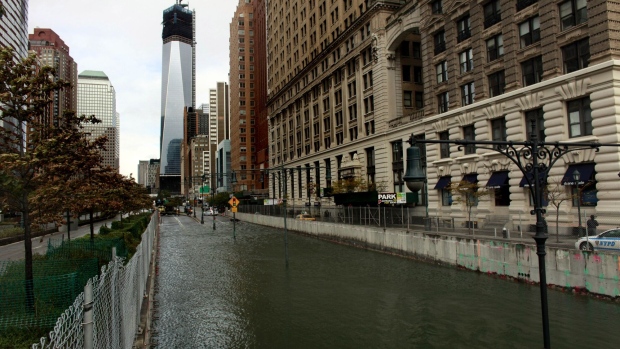Jun 28, 2023
Manhattan’s Battery Park Tries to Protect Itself From Flooding a Decade After Hurricane Sandy
, Bloomberg News

(Bloomberg) -- Over ten years after Hurricane Sandy flooded lower Manhattan, the Battery Park City Authority is set to sell about $744 million of debt with nearly half being used for sustainability projects like helping shore up the riverside community against climate change.
The group is raising funds for projects to fortify the community along the Hudson River, which is at risk from storm surges, including funding the construction seawalls and waterproofing a community center. The municipal bond sale of about $735 million in tax-exempt and $9 million in taxable bonds will also go toward restoring the Rockefeller Park House and playground, improving information technology as well as repairs to Pier A and its plaza, according to bond documents. Proceeds will also be used to refinance existing debt.
During the 2012 superstorm, floodwaters gushed into lower Manhattan from the Hudson River, damaging the Pier A Harbor House, Battery Park City Ball Fields and Asphalt Green. By 2100 — a year many young New Yorkers alive now may see — storm surges could leave nearly $14 billion or half of lower Manhattan’s properties in peril, according to a 2019 report from the New York City Economic Development Commission and the Mayor’s office.
“Battery Park City’s bonding capacity is vital to our coastal resiliency efforts to help protect the future of Lower Manhattan,” B.J. Jones, president and chief executive officer of the Battery Park City Authority said.
Jones is resigning his post effective next month and the authority is expecting to select a successor on or about July 28, according to a supplement to the bond documents filed June 27.
Battery Park City — which houses Goldman Sachs Group’s global headquarters as well as other high profile institutions including Brookfield and Stuyvesant High School — fared better during the superstorm than other less affluent parts of the city. The resiliency project is more about defending against an increasingly severe future outlook than plugging holes made evident by past climate crises, said Natalie Cohen, president of National Municipal Research, Inc.
Two series of the debt are branded with the “sustainability bond” label, meaning that projects adhere to the ESG Bond Principles and the United Nation’s Sustainable Development Goals. That designation has been verified by Sustainalytics and the authority has committed to annually reporting on its efforts in response to climate change.
Cohen said investors interested in sustainability are likely to find the bonds appealing but added that the deal’s overall strength broadens its appeal beyond the ESG-focused.
Both Fitch Ratings and Moody’s Investors Service assigned the bonds their highest investment-grade rating. The deal received a stable outlook from the two firms which pointed to Battery Park City’s diverse streams of income.
The bonds are backed by ground rent revenues and other payments from all the commercial and residential properties comprising Battery Park City including office towers, hotels and apartment buildings.
The Moody’s rating reflected “the superior credit strength provided by a pledge of ground rent revenues from all of the commercial and residential properties,” analyst Ferdinand Perrault wrote in a report. He also cited “very strong debt service coverage, and the strong likelihood of stable revenues going forward due to the quality and value of the properties.”
Morgan Stanley, who is senior manager on the deal, declined to comment before pricing.
--With assistance from Kathleen Seaman.
©2023 Bloomberg L.P.






